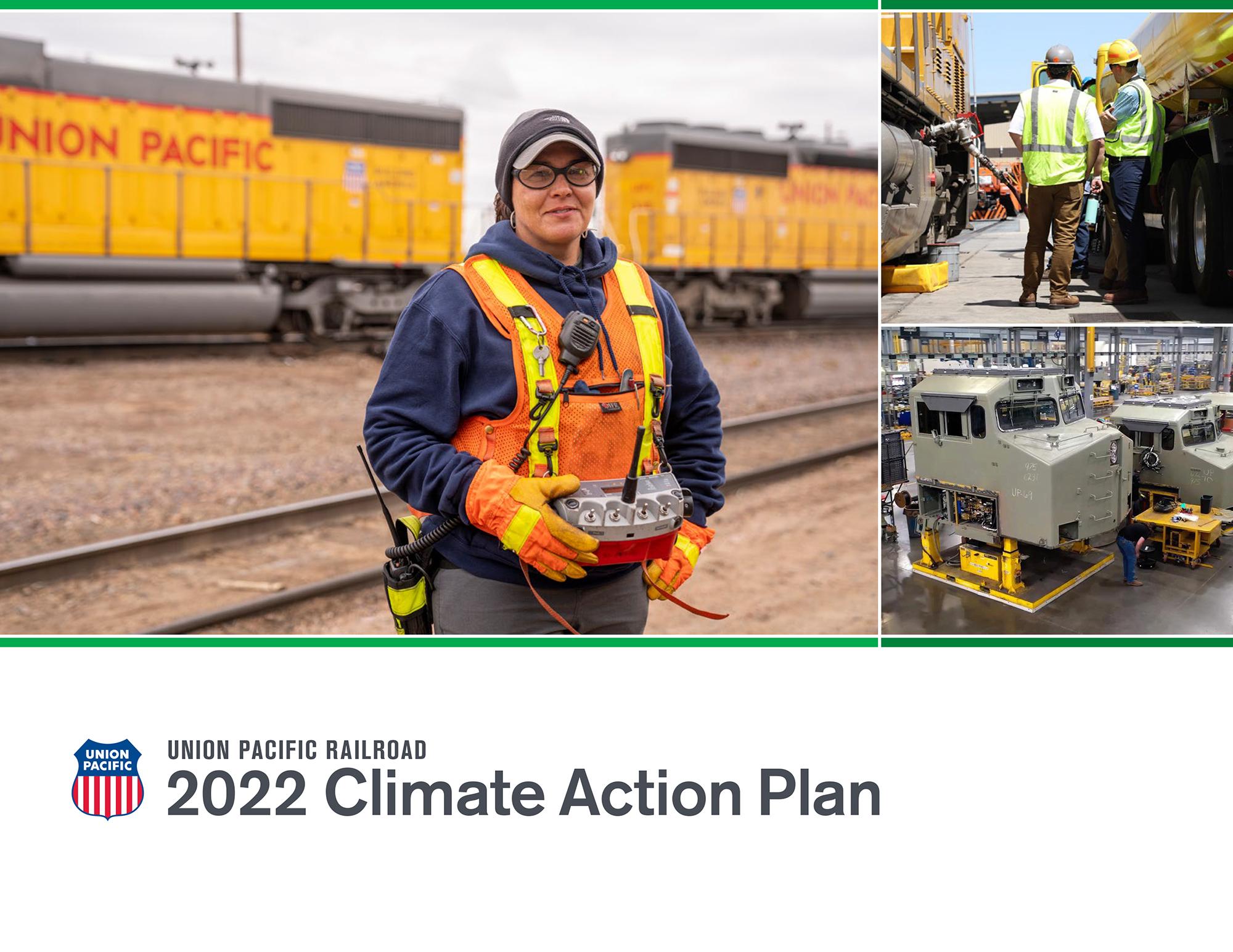Omaha, Neb.
|November 15, 2022
Union Pacific Details Efforts to Address Climate Change; Becomes First U.S. Railroad to Support Task Force on Climate-Related Financial Disclosures
Results from the railroad’s first long-term climate scenario analysis support plan to achieve net-zero greenhouse gas emissions by 2050.Union Pacific Railroad today published its second comprehensive Climate Action Plan, highlighting the significant and innovative steps taken to address climate change, while outlining long-term strategies to reduce greenhouse gas (GHG) emissions and achieve net zero by 2050.
“Last year, we embarked on a journey to improve our environmental footprint and build a more sustainable economy for generations to come,” said Beth Whited, executive vice president – Sustainability and Strategy and chief human resource officer. “Our mission continues, and we remain committed to finding and embracing bold solutions to address climate change and achieve net-zero emissions.”
Since the publication of its first Climate Action Plan in 2021, Union Pacific has taken considerable steps to reduce its environmental impact, including increasing use of low-carbon fuels and reducing fuel consumption by more than 11 million gallons in 2021 compared with 2020.
Union Pacific also reaffirmed its commitment to reach net-zero GHG emissions. Last month, Union Pacific joined the Business Ambition for 1.5°C, an alliance of more than 3,000 companies pledged to taking bold action to limit global warming to 1.5°C. As part of that pledge, we committed to the Science Based Targets Initiative (SBTi) to revalidate our short-term target in line with the 1.5°C global warming scenario and develop a long-term, science-based target to reach net-zero value chain GHG emissions by 2050.
In 2022, Union Pacific also conducted an extensive climate scenario analysis to better understand the hypothetical impacts of climate change on its operations, infrastructure, supply chains and customers under both high- and low-carbon future scenarios. The analysis is being used to evaluate and develop potential strategies that address both future risks and opportunities arising from climate change.
Additional highlights of Union Pacific’s 2022 Climate Action Plan include:
- Continued modernization of existing locomotives
- During 2021, Union Pacific continued modernizing its locomotive fleet by upgrading 120 older units. These modernizations not only improve locomotive reliability but make each unit up to 5% more fuel efficient and emit approximately 53% less emissions.
- In 2022, Union Pacific announced the largest-ever investment in modernized locomotives in rail industry history: an agreement with Wabtec Corporation for 600 locomotive modernizations, worth more than $1 billion.
- Plans to purchase new battery electric locomotives
- Union Pacific announced plans to purchase North America’s largest carrier-owned fleet of battery-electric locomotives for testing in freight yard operations and are piloting this technology in its early adoption phase to better understand how it could be deployed at scale in operations.
- Increased use of renewable and biofuels
- Working together with locomotive and fuel suppliers, Union Pacific increased its use of renewable diesel and biofuels. 2021 low-carbon fuel consumption rose to 3% of total diesel consumed, up from 2.2% in 2020. As the end of 2022 approaches, this number is climbing above 4%.
- Improved Energy Management System (EMS) utilization
- In 2021, Union Pacific’s full-year fuel consumption rate improved 1%, a new record low. This represents the third consecutive year Union Pacific improved fuel consumption rate on a year-over-year basis.
- By the end of 2022, EMS will have been implemented in approximately three-quarters of Union Pacific’s active road fleet.
- The first U.S. railroad to formally support the Task Force on Climate related Financial Disclosures (TCFD)
- This reinforces Union Pacific’s commitment to transparent disclosure. Union Pacific is committed to continuing to implement the TCFD framework in its climate reporting.
“We must continue to be forward thinking in our initiatives to see reductions in our absolute emissions. Climate change is caused by human behavior and recognizing our community impact is imperative,” said Maqui Parkerson, vice president – Labor Relations and Sustainability. “As a leader in the rail industry and critical link in the supply chain, we will continue to strive to be a leader in the overall climate solution.”
For more detailed information about Union Pacific’s commitments and progress, visit its ESG website to read the Climate Action Plan and its latest sustainability report, the 2021 Building America Report.
About Union Pacific
Union Pacific (NYSE: UNP) delivers the goods families and businesses use every day with safe, reliable and efficient service. Operating in 23 western states, the company connects its customers and communities to the global economy. Trains are the most environmentally responsible way to move freight, helping Union Pacific protect future generations. More information about Union Pacific is available at www.up.com
The statements and information contained in the news releases provided by Union Pacific speak only as of the date issued. Such information by its nature may become outdated, and investors should not assume that the statements and information contained in Union Pacific's news releases remain current after the date issued. Union Pacific makes no commitment, and disclaims any duty, to update any of this information.
